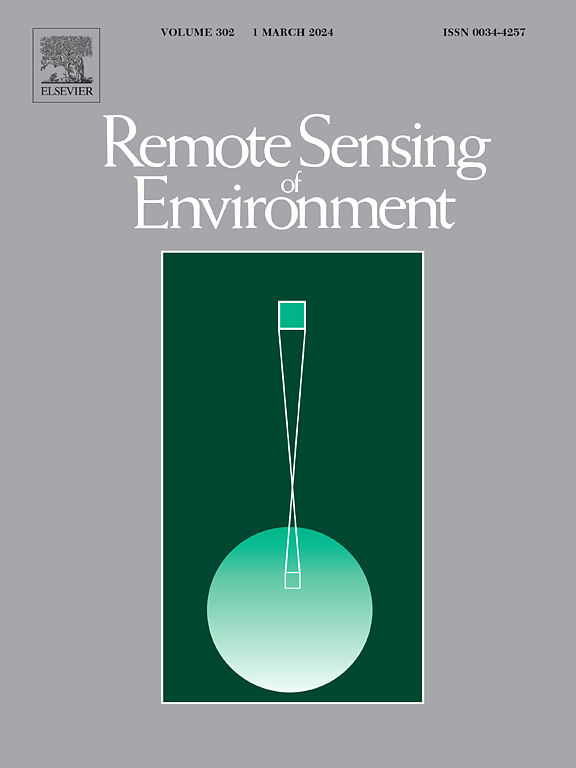A deep learning method for generating gap-free FAPAR time series from Landsat data
IF 11.1
1区 地球科学
Q1 ENVIRONMENTAL SCIENCES
引用次数: 0
Abstract
Fraction of Absorbed Photosynthetically Active Radiation (FAPAR) is a key indicator of photosynthetic activity and primary productivity in terrestrial ecosystems. While moderate-coarse spatial resolution FAPAR products have enabled global vegetation studies, their pixel sizes smooth fine-scale heterogeneity and limit applications needing a detailed spatial characterization. Landsat provides multispectral data at 30 m spatial resolution enabling global and long-term FAPAR estimation at finer spatial detail. But challenges exist in deriving continuous Landsat FAPAR time series due to infrequent clear observations. We propose here a generic two-step method to produce gap-free Landsat FAPAR time series. First, in clear-sky conditions, FAPAR is retrieved from Landsat surface reflectance observations using a random forest (RF) regression model previously trained with the Global land surface satellite (GLASS) V6 FAPAR product. In a second step, a novel Bidirectional Temporal Convolutional Network with Sparrow Search Algorithm and Attention mechanism (SSA-BiTCN-Attention) was used to reconstruct the missing FAPAR values. The temporal information of Landsat clear-sky FAPAR within a five-year window was used for predicting the missing values. The reconstruction model accurately predicted missing FAPAR values across different land cover types with RMSE ranging from 0.08 to 0.12. The validation results showed a good agreement between the estimated Landsat FAPAR and ground measurements from VAlidation of Land European Remote Sensing Instruments (VALERI), ImagineS and Ground Based Observations for Validation (GBOV), with R2 values ranging from 0.82 to 0.92, RMSE values from 0.10 to 0.12, and bias values from 0.02 to 0.05. The Landsat retrievals are consistent with GLASS and Moderate-Resolution Imaging Spectroradiometer (MODIS) FAPAR products and improve these two products in terms of accuracy and spatial resolution. As a demonstration case study, we applied our method to generate 30-m, 16-day FAPAR time series from 2013 to 2023 over China. The Landsat gap-free FAPAR product exhibits seamless spatial coverage and temporal continuity across China. This innovative method has the potential to be applied to multiple satellite data and land surface products to generate gap-free high spatio-temporal time series of land surface variables at the global scale, which will contribute in improving environmental modeling, carbon cycling studies, and agricultural applications.
基于Landsat数据生成无间隙FAPAR时间序列的深度学习方法
吸收光合有效辐射分数(FAPAR)是陆地生态系统光合活性和初级生产力的重要指标。虽然中-粗空间分辨率FAPAR产品使全球植被研究成为可能,但其像素大小平滑了精细尺度的异质性,限制了需要详细空间表征的应用。Landsat提供30米空间分辨率的多光谱数据,可以在更精细的空间细节上进行全球和长期FAPAR估计。但是,由于清晰的观测很少,在获得连续的陆地卫星FAPAR时间序列方面存在挑战。本文提出了一种通用的两步法来生成无间隙Landsat FAPAR时间序列。首先,在晴空条件下,使用随机森林(RF)回归模型从Landsat地表反射率观测中检索FAPAR,该模型先前使用全球陆地表面卫星(GLASS) V6 FAPAR产品进行训练。第二步,采用一种新颖的具有麻雀搜索算法和注意机制的双向时间卷积网络(SSA-BiTCN-Attention)来重建缺失的FAPAR值。利用Landsat晴空FAPAR的5年窗口时间信息对缺失值进行预测。重建模型准确预测了不同土地覆盖类型的FAPAR缺失值,RMSE范围为0.08 ~ 0.12。验证结果表明,估算的Landsat FAPAR与来自欧洲陆地遥感仪器验证(VALERI)、影像和地面观测验证(GBOV)的地面测量值具有较好的一致性,R2值为0.82 ~ 0.92,RMSE值为0.10 ~ 0.12,偏差值为0.02 ~ 0.05。Landsat反演结果与GLASS和MODIS FAPAR产品基本一致,并在精度和空间分辨率上有所提高。作为示范案例研究,我们应用我们的方法生成了中国2013年至2023年的30 m, 16天FAPAR时间序列。Landsat无间隙FAPAR产品在中国具有无缝的空间覆盖和时间连续性。这种创新方法有可能应用于多个卫星数据和地表产品,从而在全球范围内生成地表变量的无间隙高时空时间序列,这将有助于改进环境建模、碳循环研究和农业应用。
本文章由计算机程序翻译,如有差异,请以英文原文为准。
求助全文
约1分钟内获得全文
求助全文
来源期刊

Remote Sensing of Environment
环境科学-成像科学与照相技术
CiteScore
25.10
自引率
8.90%
发文量
455
审稿时长
53 days
期刊介绍:
Remote Sensing of Environment (RSE) serves the Earth observation community by disseminating results on the theory, science, applications, and technology that contribute to advancing the field of remote sensing. With a thoroughly interdisciplinary approach, RSE encompasses terrestrial, oceanic, and atmospheric sensing.
The journal emphasizes biophysical and quantitative approaches to remote sensing at local to global scales, covering a diverse range of applications and techniques.
RSE serves as a vital platform for the exchange of knowledge and advancements in the dynamic field of remote sensing.
 求助内容:
求助内容: 应助结果提醒方式:
应助结果提醒方式:


